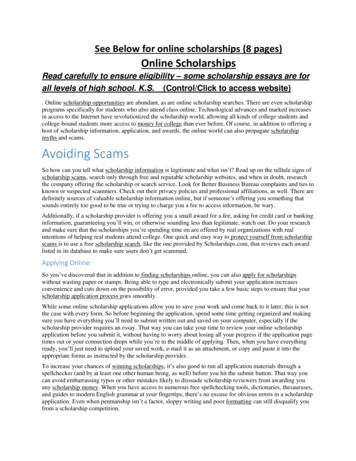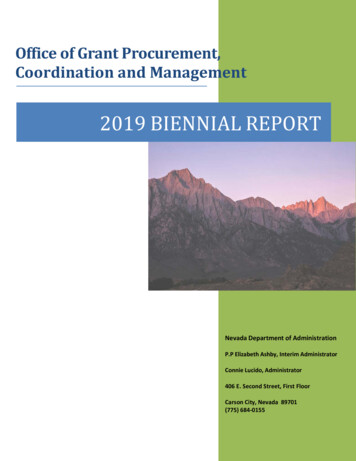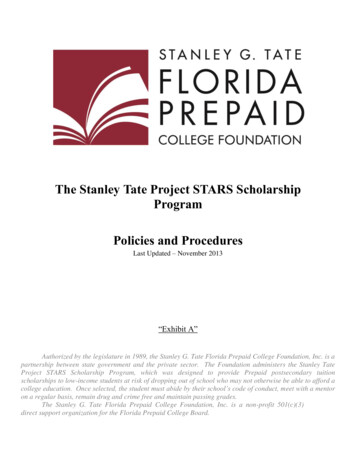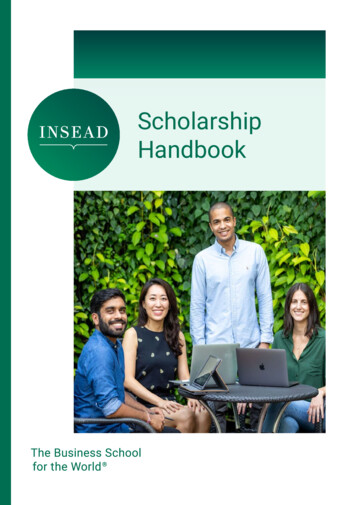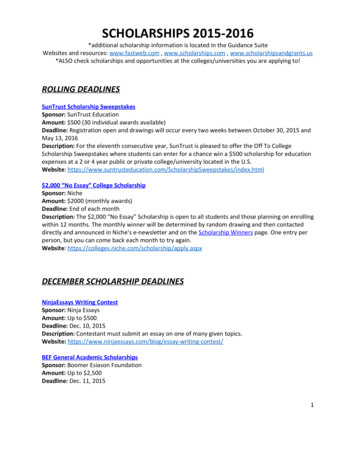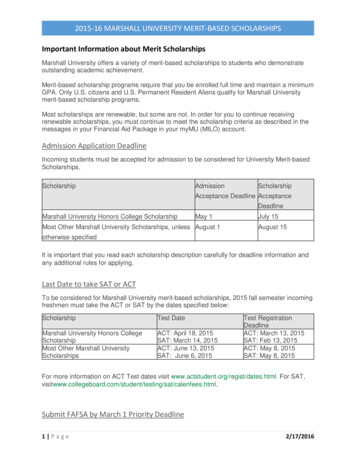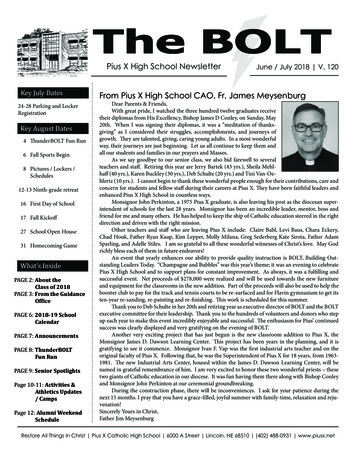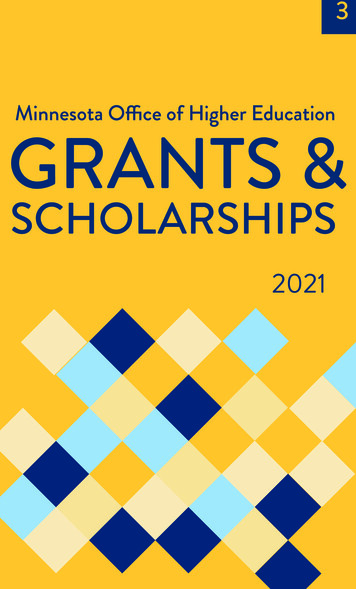
Transcription
3GRANTS &SCHOLARSHIPS2021
Scholarships and grants are fnancialaid you don’t need to repay.But what other types of fnancial aid are available?Financial aid comes in three forms:Aid you must repay (loans)213Aid you don’t repay(grants and scholarships)Aid you earn(work study andmilitary assistance)Other forms of aid include community service education benefts,reduced tuition programs and government tax benefts.Use www.ohe.state.mn.us/estimator to estimate your eligibility for the Federal PellGrant, Minnesota State Grant, and federal education tax benefts.1
GrantsThe government awards grants based on fnancial need.Grants are a large source of fnancial aid.Federal Pell GrantFor 2021-2022, Pell Grants range from 650- 6,495 per academic year.Students with family incomes up to 65,000 may be eligible for a federal Pell Grant,although most awards go to students with lower family incomes.Eligibility:You may receive a Pell Grant for your undergraduate study until you complete a bachelor’sdegree, or receive a grant for the equivalent of 12 full-time semeters, whichever comesfrst. You may use it at almost any college. In some cases, you may receive a Pell Grant forattending a post-graduate teacher certifcation program.In addition to meeting fnancial eligibility requirements, students must: Be enrolled in a program leading to a certifcate, degree or diploma at a collegeeligible to participate in the Federal Pell Grant program. Male students must sign a statement of registration status indicating that youhave either registered with the Selective Service (www.sss.gov) or that you arenot required to register. Have a high school diploma, including home school or GED. (Some exceptions apply.) Maintain satisfactory academic progress. If you are receiving federal studentaid, you must maintain a “C” average and stay within your institution’sgraduation standards. You must be completing enough courses each term tograduate in a timely manner. Sign a statement that you do not owe a refund on a Pell Grant, are not in defaulton a federal loan, and that you agree to use your student aid only for educational purposes. Not be convicted for the possession or sale of illegal drugs while receivingfederal fnancial aid. Be a United States citizen or eligible non-citizen.You are an eligible non-citizen if you: Have a Permanent Resident Card (I-551). Are a conditional permanent resident with an 1-551C Card. Have an Arrival Departure Record (I-94) from the Deparment of Homeland Securitywith any of the following designations: refugee, asylum granted, parolee, victim ofhuman trafcking, T-Visa holder, or Cuban-Hatian entrant.2
What is the Selective Service System?The Selective Service System is an independent agency of the U.S. Government thatmaintains information on males potentially subject to military draft.How do you know if you should register for Selective Service?You must register if you are a male born on or after January 1, 1960, are 18-25 andnot currently on active duty in the armed forces. This requirement also applies toundocumented students.3
Application:Your Federal Pell Grant is given out after youcomplete the Free Application for Federal StudentAid (FAFSA). You may apply for aid for the 20212022 school year after October 1, 2020 and untilJune 30, 2021. Students must apply each year to renewtheir grants.Minnesota State GrantThe Minnesota State Grant Program is a state-funded need-based program and is available forstudents who have not yet attended eight full-time semesters of postsecondary education or theequivalent. To receive a State Grant for a term, the FAFSA must be submitted to the federalprocessing center within 30 days of the school’s term start date. The average award for a full-timestudent for one year is about 1,857.Eligibility: Minnesota residents who enroll for at least three credits as undergraduate students inprograms leading to certifcates, degrees or diplomas at a participating school in Minnesota.Minnesota Residency Requirements:To be considered a Minnesota Resident student, a student must meetONE of the following criteria: Graduated from a Minnesota high school while residing in Minnesotaand physically attending a Minnesota college (if temporarily residingin another state). Received a GED in Minnesota after living in the state for at least one year. Lived in Minnesota for at least one year for other than educational purposes(not enrolled for more than fve undergraduate credits in any term duringthat time). Had parents residing in Minnesota when the fnancial aid application wassubmitted (dependent students only). Relocated to Minnesota as a refugee and continued to reside in Minnesota. A spouse or dependent of a veteran, if the veteran is a Minnesota resident. An active member (or spouse or dependent) of the Minnesota NationalGuard or a reserve component of the U.S. Armed Forces whose duty station islocated in Minnesota, and who resides in Minnesota. Stationed in Minnesota as a member (spouse or dependent) of the UnitedStates armed forces on active federal military service. Relocated to Minnesota within 12 months of a presidentialdisaster declaration if the disaster interrupts the student’spostsecondary education.4 Meet the requirements under the Minnesota Dream Act see Book #2 (FAFSA).
How Does the State Grant Work?The State Grant Program is coordinated with the Federal Pell Grant Program. Students areresponsible to pay at least 50 percent of their cost of attendance from savings, earnings, loans, orother fnancial aid from the college or a private source. The following example uses 2019-2020 data.The cost of attendance comprises: Tuition and fees A standard allowance established by the Minnesota Legislature for room and board, books,school supplies, and miscellaneous expenses.Example:A dependent student attending a Minnesota State University for 15 credits each semesterwith a family income of 25,000. The Expected Family Contribution (EFC) is 0.Cost of Attendance Average Tuition and Fees 8,806 Living and Misc. Allowance 9,930Total 18,736 Student Responsibility 9,368 Pell Grant 6,195 State Grant 3,173Total 18,736The student would be eligible for federal and state grants totaling 9,368.Students may receive additional grant assistance from other sources.This does not afect the size of the State or Pell Grant.Federal Supplemental Educational Opportunity Grant (SEOG)The Federal Supplemental Educational Opportunity Grant Program makes awards to exceptionallyneedy students and can add 100 to 4,000 in grant money to the fnancial aid package. The awardamount is set by the institution’s fnancial aid ofce and depends on the availability of funds at yourschool and the amount of other aid you are receiving.Eligibility:Only undergraduate students are eligible. Priority is given tostudents already receiving a Pell Grant. Students must beUnited States citizens or eligible non-citizens.Application:The fnancial aid ofce at your school will use your FAFSAresults to determine the size of your award. Deadlines diferfrom school to school, apply as early as possible.5
Minnesota Postsecondary Child Care GrantStudents who have children 12 and under (14 and under if disabled) and demonstrate fnancial needmay receive assistance under the Minnesota Postsecondary Child Grant Program to help pay for childcare. The fnancial assistance may cover up to 40 hours per week per eligible child. The amount ofthe grant award is based on the income of the applicant and spouse, number in the applicant’s family,number of eligible children needing child care, the actual cost of child care, and whether the student isenrolled full or part time. Grants are available for both undergraduate and graduate students.Eligibility:You are eligible to apply for a Postsecondary Child Care grant if you: Are a resident of Minnesota, including spouses of Minnesota residents andundocumented students who qualify under the MN Dream Act Have a child 12 years of age or younger (14 years of age or younger if disabled),who is receiving or will receive care on a regular basis from a licensed or legalnon-licensed care giver Meet the program’s income guidelines Are enrolled at least half time (six or more credits for undergraduates; 1 or more creditsfor graduate students) in an eligible institution Undergraduates have not earned a bachelor’s degree or been enrolled for the equivalentof eight full-time semesters or 12 full-time quarters (an additional term of eligibility isavailable for students who have withdrawn from school for active military service afterJanuary 1, 2013 or for a major medical illness). Graduate and Professional studentshave an additional 4 years of eligibility after receiving a bachelor’s degree. Are pursuing a nonsectarian program or course of study that applies to anundergraduate degree, diploma or certifcate Are in good academic standing and making satisfactory progress toward a degree,diploma, or certifcate Are not receiving tuition reciprocity Are not in default on any educational loan or, if in default, have made satisfactoryarrangements to repay the loan with the holder of the note Are not receiving Minnesota Family Investment Program or Diversionary Work Programbenefts during the same term you receive a Postsecondary Child Care grant(A student who receives an award and then receives benefts from the MFIP programduring the same quarter must inform the school within 10 days)Application:You must apply for the Postsecondary Child Care grant through the fnancial aidofce at your school.ScholarshipsScholarships are awarded based on criteria such as academic orathletic achievement, cultural or religious background or specialskills and talents. Some colleges require students to complete theCSS Profle, an in-depth assessment of fnancial need.Be sure to check with each college’s fnancial aid ofce to identifyscholarships. You often need to complete scholarship applicationforms in addition to the FAFSA, and deadlines are early!For a partial list of institutional scholarships in Minnesota,visit www.ohe.state.mn.us/mnscholarships.6
Minnesota Indian Scholarship ProgramScholarships are available to eligible American Indian students who are either undergraduatestudents enrolled at least three-quarter time or graduate students enrolledat least half time.Eligibility:In order to qualify for this scholarship, you must be: One-fourth or more American Indian Minnesota resident for state fnancial aid purposes Enrolled in an accredited college, university or vocational school in Minnesota Undergraduates must qualify for a Pell or State Grant; graduate studentsmust demonstrate needApplication:Students should complete the FAFSA and complete an application atwww.ohe.state.mn.us/indianscholarship. The priority deadline for complete applicationsis July 1.Information and application forms also available from:Minnesota Indian Scholarship Program at the Minnesota Ofce of Higher EducationTelephone: (651) 642-0567 or (800) 657-3866E-mail: info.ohe@state.mn.usWhere to Find Private ScholarshipsMany community organizations, foundations, corporations, clubs, civic, and cultural groupsprovide student scholarships.If you’re looking for private sources of fnancial aid, you should: Check with your or your family’s employer, professional association, or labor union Ask if your employer has an education policy that pays for employees to enroll injob-related postsecondary courses Inquire at community organizations such as the Chamber of Commerce,churches, or Rotary Clubs Check with your high school counselor Search online using one of the free scholarship search sites listed belowScholarship ResourcesScholarship Handbook, 2020. It can be purchased at www.collegeboard.org.Your local library has a scholarship search, and may have a copy of the handbook andother books available.Scholarship SearchesCollegeNet www.collegenet.comFastWeb www.fastweb.comMinnesota Institutional Scholarships www.ohe.state.mn.us/mnscholarshipsScholarships.com www.scholarships.comWork-Study ProgramsYou may earn money to help pay for your education by working at part-time jobs on or of campusthrough either the Federal Work-Study Program or the Minnesota Work-Study Program. Schools mayinclude a work-study job as part of your fnancial aid package. The fnancial aid ofce at the school youattend determines the size of the work-study award. Participating students work an average of 15 hoursper week and may earn 3,000 or more per year. Your fnancial aid ofce will consider your work-studyaward amount, schedule, job skills, and academic program to determine how many hours you can work.7
Eligibility:Undergraduate and graduate students are eligible underboth federal and state work-study programs.To be eligible for Federal Work-Study, the student must: Be a U.S. citizen or eligible non-citizenBe enrolled in a program leading to a degree, certifcate, or diplomaBe registered with the Selective Service if maleNot be in default on a student loanNo previous convictions for possession or sale of illegal drugs while receiving federalfnancial aid Be making satisfactory academic progressTo be eligible for Minnesota Work-Study, the student must: Be a Minnesota resident and attend a participating Minnesota school Be enrolled for at least six credit hours per term in a program leading to a degree,certifcate, or diploma Be making satisfactory academic progress Undocumented students under DACA with work authorization are eligible for fundsApplication:The fnancial aid ofce at the school you attend or plan to attend will use the resultsfrom your FAFSA or Dream Act Application (for undocumented students) to determineyour eligibility for work study.Community Service BeneftsAmeriCorpsAmeriCorps is a cooperative efort by local agencies and federal and state governments to providecommunity service throughout the country. Hundreds of community service opportunities are availableto help fnance part of the participant’s education at any federally-recognized institution. AmeriCorpsgraduates may receive educational loan benefts.Eligibility:To be eligible for AmeriCorps positions, you must be 17 years of age or older, have a highschool diploma or a GED (or are completing a GED), and be a U.S. citizen or an eligiblenon-citizen.Application:For more information on AmeriCorps, visit www.americorps.gov. For information onMinnesota opportunities, call ServeMinnesota at (612) 333-7740, or visit www.serveminnesota.org.Financial Assistance for Military ServiceThose called to active duty while enrolled in college receive certain protections regarding fnancial aideligibility, enrollment status, and loan repayment. In most instances, the student will not be penalizedas a result of his or her absence to perform active military service. Check with the school’s fnancial aidofce for more details.If you are currently enlisted in any branch of the military, check directly with your unit about educationbenefts. In addition, there are federal and state educational benefts for students who have served orare serving in the armed forces.For more information regarding veteran’s education benefts, visit https://linkvet.org/app/custom/educationPlease note that not all programs can be used for all types of training.8
FederalPost-9/11 GI BillThe Post-9/11 GI Bill provides up to 36 months of educational benefts to eligible veterans. The billbecame efective August 1, 2009. You may be eligible if you have at least 90 days of aggregateservice on or after September 11, 2001 or if you were discharged after September 11, 2001 with aservice-connected disability after 30 days.Forever GI BillThe Forever GI Bill ends the 15-year limit on Post 9/11 GI Bill usage, allowing use of benefts forlife for those discharged on or after January 01, 2013.Federal – Montgomery GI Bill – Active DutyThe Montgomery GI Bill – Active Duty, provides up to 36 months of education benefts to eligibleveterans. You may be eligible if you entered active duty for the frst time after June 30, 1985 andelected to pay into the program, served two or more years of active duty, were honorably discharged,and you have a high school diploma or GED.Application: Visit www.gibill.va.gov for up-to-date information on these benefts, or contacta Minnesota Department of Veterans Afairs Regional Coordinator on the campus you choose toattend. Visit www.mymilitaryeducation.org to fnd a local Campus CoordinatorTo learn more, contact your institution’s fnancial aid ofce or the Minnesota Department of VeteransAfairs.Federal Tuition Assistance (FTA) ProgramArmy National Guard and Reservists may be eligible for this program while pursuing any degree upthrough a master’s degree. Service members should check with their unit or a Higher EducationVeterans Program coordinator for eligibility and application information. This is not a guaranteedbeneft and is ofered on a frst-come, frst-served basis. Generally, you must submit the applicationbefore the term begins.Application:Visit www.goarmyed.com or contact a Minnesota Department of Veterans Afairs RegionalCoordinator for the campus you choose to attend.Visit https://linkvet.org/app/custom/education to fnd a local Campus Coordinator.Minnesota GI BillThe Minnesota GI Bill provides funding for eligible applicants who are in a Title IV eligible certifcate,diploma, undergraduate or graduate program. Applicants may receive up to 3,000 per academicyear.Eligibility:You must be a Minnesota Resident Student enrolled at a participating Minnesotainstitution and a: Veteran who is serving or has served honorably in any branch of the UnitedStates armed forces at any time; or Non-veteran who has served honorably for a total of fve years or more cumulativelyas a member of the Minnesota National Guard or any other active or reservecomponent of the United States armed forces, and any part of that service occurred onor after September 11, 2001; or Spouse or dependent child of a person who has served in the military at any time,and who has died or has a total and permanent disability as a direct result of thatmilitary service.9
Application:Contact your school’s fnancial aid ofce, the Minnesota Department of Veteran’s Afairs at www.gibill.mn.gov or call 888-546-5838 with questions. You also may wish to contact a MinnesotaDepartment of Veterans Afairs Regional Coordinator for the campus you choose to attend. Visitwww.mymilitaryeducation.org to fnd a local Campus Coordinator. You may be required to providedocumentation of military service.Minnesota State Tuition Reimbursement (STR) for Air andArmy National GuardThe Minnesota Tuition Reimbursement program provides fnancial assistance for Minnesota Air andArmy National Guard members. The program reimburses members for coursework satisfactorilycompleted at any school, in-state or out-of-state, approved for veterans benefts.Eligibility:You must be an active member of the Minnesota Army or Air National Guard pursuingundergraduate or graduate coursework at any school approved for veteran’s benefts.Qualifying students may use Federal Tuition Assistance and State Tuition Reimbursementtogether, up to (but not to exceed) 100 percent of tuition and fees.Surviving Dependent Eligibility:If a member of the Minnesota National Guard is killed inthe line of state active service or federally-funded stateactive service, the member’s surviving spouse and anysurviving dependents who have not reached 24 years ofage are eligible for tuition reimbursement.Application:Contact the County Veterans Service Ofce in the county in whichyou live or contact a Minnesota Department of Veterans AfairsRegional Coordinator to the campus you choose to attend.Visit https://linkvet.org/app/custom/education to fnd a local Campus Coordinator.Webpage: pousebeneft.jspMinnesota Educational Assistance for VeteransThe state of Minnesota provides educational assistance for veterans who attend an approvedpostsecondary institution in Minnesota. Veterans may qualify for a one-time stipend of 750.Eligibility:To be eligible, you must provide a statement from the U.S. Department of VeteransAfairs indicating you have used all federal education benefts available; and were a resident ofMinnesota for six months prior to your induction into the armed forces.Application:Contact the Minnesota Department of Veterans Afairs (see below), or contact a MinnesotaDepartment of Veterans Afairs Regional Coordinator to the campus you choose to attend. Visithttps://linkvet.org/app/custom/education to fnd a local Campus Coordinator.10
Minnesota Surviving Spouse/Dependent Education BeneftsAn eligible spouse or child of a deceased veteran who died as a result of the person’s military serviceand who was a resident of Minnesota may be eligible to receive up to 750 per year from theMinnesota Department of Veterans Afairs. Eligible spouses and dependents may also qualify foradmission to Minnesota public colleges and universities free of tuition until they complete a bachelor’sdegree or equivalent.Eligibility:To qualify, the student must be the surviving spouse or dependent of a deceased veteranwho died as a result of their military service and was a Minnesota resident when enteringthe U.S. Armed Forces or who was a resident for at least six months prior to passing awaydue to a service-connected disability. The student must be a Minnesota resident for statefnancial aid purposes and meet satisfactory academic progress requirements at theircollege or university.Application:Contact the County Veterans Service Ofce in the county in which you live or theMinnesota Department of Veterans Afairs at:Veterans Services Building, 2nd Floor20 West 12th StreetSt. Paul, MN 55155Tel: (651) 296-2562Web: www.mdva.state.mn.usMilitary Education Benefts InformationMinnesota Department of Veterans AfairsVeterans Linkage Line: 1-888-546-5838https://mn.gov/mdva/Higher Education Veterans ional Guard Federal Tuition Assistancewww.goarmyed.comU.S. Department of Veterans Afairswww.gibill.va.govMinnesota Ofce of Higher Educationwww.ohe.state.mn.us/militaryFinancial Aid for Specifc PopulationsAdditional aid may be available to you based on criteria in addition to your fnancial need.The programs described here are only a few of those available.Scholarships for Students of ColorThere are several private scholarship programs for students of color. Search your college’s website forscholarships specifc to your identities.Orphaned or Foster ChildrenOrphans and those who were in foster care may be eligible for an increased level of fnancial aidassistance. Orphans, wards of the court, and children placed in foster care any time since they turned13 are considered independent students and are not required to submit fnancial information about11
their parents on the FAFSA.If you attend a Minnesota state college or university, you may be eligible for a tuition waiver forcertain courses or programs. Check with the college for more details.Education and Training Vouchers for Former Youth in CareEducation vouchers are federal funds made available to states through the Chafee Foster CareIndependence Act. Education vouchers are intended to help current and former foster care youth payfor postsecondary education. The award amount is based on the amount of other aid the student isreceiving, and an estimated living expenses budget which is a part of the application.Eligibility:You must be under age 21 at the application due date, accepted into an accreditedpostsecondary program, and meet at least one of the following requirements: In foster care on or after your 16th birthday Adopted from foster care after your 16th birthday In foster care on or after your 16th birthday when a relative accepts a transfer ofpermanent legal and physical custody through a juvenile court order Are or were under state guardianship on your 18th birthdayApplication:Applications are available at mn.gov/dhs/ and search for Education and Training Voucher(ETV) Program and for Foster Youth under the letter E.To apply for an initial voucher, you must attach a copy of your fnancial aid award, FAFSA,postsecondary school acceptance letter, and most recent transcripts. Students mayreapply for education/training vouchers every year until age 23 if they are participatingin the education/training voucher program and making satisfactory progress. Additionalquestions can be directed to the Education and Training Voucher Program at theMinnesota Department of Human ServicesTelephone: (651) 431-4663E-mail: dhs.etvcoordinator@state.mn.usStudents Who Are Deaf or BlindMinnesota residents admitted to the University of Minnesota who are blind may be eligible for atuition waiver from the university. Minnesota residents who are deaf and who qualify for either a Pellor State Grant may be eligible for tuition and fee assistance at the public college or university to whichthey have been admitted. Contact the college’s fnancial aid ofce to learn more.American Indian StudentsAmerican Indian students in Minnesota may be eligible for additional fnancial aid from the state ofMinnesota, the U.S. Bureau of Indian Afairs, and their tribe.American Indian Tuition WaiverThe American Indian Tuition Waiver at the University of Minnesota—Morris recognizes the campus’origins as the Morris Indian Boarding School founded in the 1800s. American Indian studentsadmitted to the University of Minnesota—Morris may apply for this waiver by submitting theAmerican Indian tuition waiver application and supplying acceptable documentation.12
Eligibility:To qualify for this beneft, students must be accepted by the university’s admissionsofce, complete the American Indian Tuition Waiver application, and provide AmericanIndian heritage documentation, which may include the following: Tribal registration proving membership in a federally-recognized American Indian tribe Certifcate of Indian blood Other legal documentation of American Indian heritageApplication:Complete the application at tudents with questions should call (800) 992-8863 or e-mail morrisfa@morris.umn.edu.Dependents and Spouses ofPublic Safety OfcersDependent children and the surviving spouse of a public safety ofcer killed in the line of duty areeligible to receive educational benefts through the Public Safety Ofcers’ Survivor Grant Program.Eligibility:To qualify for this award, you must be a dependent or spouse of a public safety ofcerkilled in the line of duty on or after January 1, 1973. Dependents must meet the followingrequirements: Less than 23 years old or less than 30 years old if served on active military dutyfor 181 consecutive days or more, and was honorably discharged or released Enrolled in an undergraduate or certifcate program at one of the postsecondaryinstitutions in Minnesota that participate in the State Grant program.Surviving spouses of all ages and dependents under age 23 are also eligible to useawards for graduate study.Application:Applicants need to take a certifcate of eligibility to the fnancial aid ofce of the schoolthey attend or plan to attend. This certifcate can be obtained from:Commissioner’s Ofce Minnesota Department of Public SafetyTelephone: (651)201-7160Alliss Opportunity Grant Program for Adults Returning to CollegeTwo Year College Opportunity Grant ProgramEligibility: Grants are available to students with fnancial need who are attending Minnesota State Colleges, enrolled in A.A., A.S., A.A.S., A.F.A., diplomas, certifcates, and MnTCcourses designed to transfer to baccalaureate programs.Recipients cannot have already received a baccalaureate degree.Recipients do not have to be Minnesota residents.Grants will be processed and awarded through the college’s normal fnancial aidapplication process and may be used to meet remaining need after the student hasreceived Pell and/or MN State Grants.Recipients will be required to meet with an advisor to create a baccalaureatedegree-completion plan. This meeting must occur during the semester for whichthe award is granted.13
Award Procedure:The procedure for selecting recipients of the Alliss Opportunity Grant varies fromcampus to campus. Please contact the fnancial aid ofce at the college you attend(or plan to attend) for more information.University Grant ProgramEligibility: Grants are available to students with fnancial need who are attendingMinnesota State Universities. Students must be enrolled full time in an undergraduate-level program of study. Scholarships are not confned to students with the highest scholastic rank;the upper 40% of any class are eligible and lower ranks are entitled to consideration.Assistance for Dislocated WorkersDislocated Worker Programs serve individuals dislocated from long-held jobs.These programs focus on upgrading current job skills, retraining, and providing supportservices. Inquire about Dislocated Worker Programs at local WorkForce Centers.Visit www.positivelyminnesota.com/dw to fnd the center nearest you.Financial Aid for Students in SpecifcProgramsHealth Professions Loan ProgramsVarious federal scholarship and loan programs are available for students interested in healthprofessions, such as nursing, dentistry, pharmacy, optometry, or medicine. Campus-based programsinclude the Health Professions Student Loan Program, the Primary Care Loan Program, Loans forDisadvantaged Students Program, and Nursing Student Loan Program.Application:Students should contact the fnancial aid ofce at the school where they are enrolled orintend to apply for admission. Visit http://bhpr.hrsa.gov to learn more.Contact frpinfo@hrsa.gov with questions.State Health Professions Loan ForgivenessThe Minnesota Department of Health’s Ofce of Rural Health and Primary Care administers loanforgiveness programs for the following health professionals:Rur
Scholarships. Scholarships are awarded based on criteria such as academic or athletic achievement, cultural or religious background or special skills and talents. Some colleges require students to complete the CSS Profle, an in-depth assessment of fnancial need. Be sure to check with each college's fnancial aid ofce to identify scholarships.

